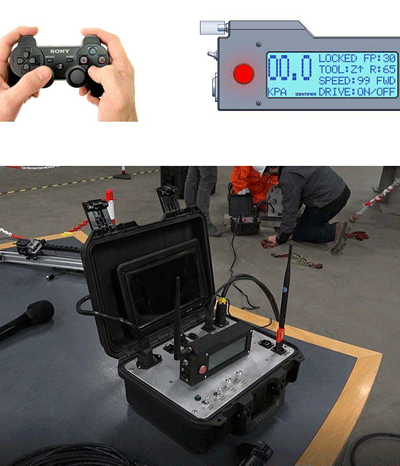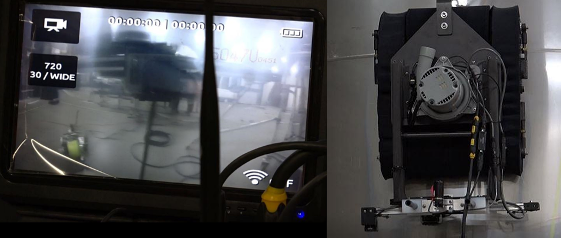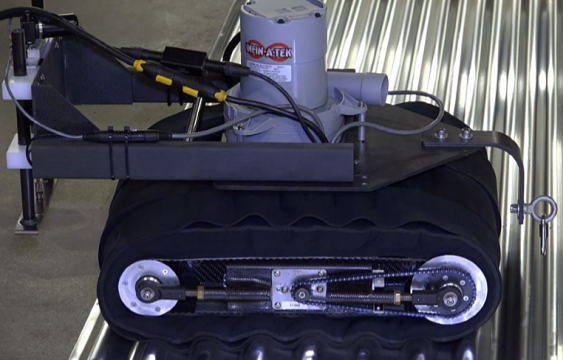Global oil and gas operator Shell (The Hague, The Netherlands) recently contracted robotics inspection consultant Quasset (Hilversum, The Netherlands) to assess the capabilities of a new, vacuum-powered robotic device to traverse surfaces and potentially detect corrosion under insulation (CUI) in a petrochemical plant environment.
Evaluations were carried out inside test chambers at the consultant’s headquarters, with the robot placed on structures designed to replicate tanks found at a petrochemical plant. Tests were carried out in close collaboration with the robotics technology provider and operator, thus allowing for immediate feedback on any challenges encountered.
The consultant was hired to evaluate the robot’s ability to climb on and potentially provide substrate inspections beneath claddings of aluminum, stainless steel (SS), galvanized steel, and even corrugated surfaces, says Sam Maggio, president of International Climbing Machines (ICM) (Ithaca, New York, USA), which developed the robot. “The inspections would primarily be performed on insulated tanks and piping, but what they evaluated for and how the robot performed could apply to many applications and many markets worldwide.”
The robotic climber has already been deployed for inspection activities on dams, water towers, windmills, and aircraft, according to ICM. However, the robot is seen as particularly useful for CUI inspections in oil and gas facilities—where insulation is required to protect workers, retain process temperatures, and control condensation, yet often hinders the ability to visibly monitor external surfaces for signs of corrosion. In petrochemical plants, where potentially hazardous chemicals are stored, the use of robotic devices can also prevent workers from having to enter the area at all, or attempting to navigate the various contours and angles.
For the evaluations in this study, the robot was equipped with various nondestructive testing (NDT) tools attached to it, such as a cylindrical transducer and an analog-to-digital data acquisition board.
Robot Features
 The ICM Climber† solution is described as a crawling robotic platform that relies on a flexible rolling seal around a vacuum chamber. The robot, which secures suction through a ventilator system, was developed to climb and adhere to any hard surfaces such as concrete, brick, and metals while overcoming any surface irregularities.
The ICM Climber† solution is described as a crawling robotic platform that relies on a flexible rolling seal around a vacuum chamber. The robot, which secures suction through a ventilator system, was developed to climb and adhere to any hard surfaces such as concrete, brick, and metals while overcoming any surface irregularities.
Weighing 45 lb (20 kg), the tethered robot is operated remotely and includes a camera system that feeds real-time information to the operating station. Although it is preferable for the robot to remain in sight of the operator, the camera system does allow for the robot to perform when out of the operator’s visual range.
Information is sent back to the operating station, including details on the speed and vacuum pressure. For example, the consultant’s report says the vacuum pressure often varies when encountering surface irregularities, and sending the data to the station allows the operator to manage such variables.
The robot is controlled by a remote control designed to resemble a gaming device, making it intuitive to use. Power to the robot and vacuum parameters can be modified from the remote control, while the speed of the robot’s drive can be either manually set or automated with a cruising speed.
The robot can also be used in tandem with a fall arrester system, designed to catch the robot and prevent it from falling if it loses traction or power. While the robot does not require the fall protection system to function, it can help prevent potential damage. Fall protection equipment is connected to the control station via a tether cable, which allows the fall arrester to react to the robot’s movements—either by spooling the cable when manually driving the motor, or engaging a lock when a sudden drop in vacuum pressure is detected.
Successful Testing Outcomes
According to the report, the climber showcased good mobility when climbing on the outside of a testing chamber and on each of its aluminum, SS, and galvanized steel substrates. Designed to simulate a closed vertical tank at a petrochemical plant, each side of the chamber and its “dome” top is constructed of a different metal substrate for testing purposes.
“The robot was able to move horizontally, vertically, and diagonally along the cylindrical shape of the vessel body, as well as on the top dome and the bottom cone,” the consultant writes in its report.1 “The robot also has the ability to be very precise in its movements; it could steer near edges, along seams, and avoid obstacles like nozzles and the manhole that were left exposed.”

The robot utilizes two types of tracks to form a seal around the vacuum chamber. Standard flat tracks over the robot’s wheels are used to navigate flat and smooth surfaces, while rubber "flappy" tracks with ridges for additional traction are used to handle concrete or dirty surfaces. Dirty surfaces were replicated in the chamber by covering a galvanized steel test plate with sand, dirt, snow, and oil—but despite these elements, the climber still adhered by forming a vacuum seal and performed scanning patterns on the plate.
One problem arose on the test chamber in an area where two segments of metallic cladding had not been affixed together. When the robot traversed this, it pulled the two segments of cladding apart and created an air gap—making a larger separation between the metal sheets and breaking the vacuum’s seal. The problem was resolved by turning down the suction force of the robot when clearing the seam.
“The ability to fine tune the speed and suction force of the robot means the robot is able to transition from one part of the vessel to the next,” the report states. “This was exemplified by the robot driving up the [SS] façade, transitioning through a multitude of seams and bolts onto the top dome, and driving back down on the other side of the vessel—the galvanized steel façade.”
While SS was the most slippery surface, it did not hinder the robotic climber from forming a vacuum seal and moving freely. The climber also showed an ability to overcome surface defects, such as dents and holes. To simulate the robot’s ability to adhere to surfaces while adding even more NDT equipment to it, 11-lb (5-kg) weights were stacked to the back of the robot to test whether the vacuum force would allow for extra loads.
“The robot was able to adhere and move on the pressure vessel body without hindrance, illustrated by its ability to perform scanning patterns vertically on the pressure vessel body without hindrance,” the report notes when explaining the added weight testing. “Some caution was exercised by the robot operator when performing a turn to perform horizontal scanning patterns on the vessel body. However, once the robot was lined up in the right direction, it could also carry the extra weight to its side.”
Areas for Further Improvement
The various trials were not without pitfalls. For example, while the robot could transition from the cylinder of the chamber to the dome shape at the top, it was not able to transition over sharp edges at the bottom—since this broke the vacuum seal.
Separately, the robot also struggled with the corrugated test plate, as the robot was only able to move and adhere perpendicularly to the corrugation.

“The seal of the vacuum broke at a 30-degree angle to the corrugation, and this could not perform any turns and very limited scanning patterns,” the report states. “As suggested by the robot operator, one possible way of maintaining a vacuum seal at all angles would be to install the flappy tracks on all sides of the vacuum chamber: front, back, left, and right. Although this would entail a few design changes, it would allow the climber to navigate corrugated surfaces in all directions.”
The consultant also noted that since the robot ensures suction through its ventilator system, there could be a risk that the ventilator sucks unwanted or dangerous liquids and gases into the robot, depending on the inspection environment. Based on this and other reasons, the consultant is urging the technology provider to develop a written safety standard.
“Having the robot independently reviewed for safety by an entity with ATEX expertise could serve as a first step to review the robotic system and recommended safety improvements,” the report says. ATEX is a European Union directive for protection against explosive atmospheres.
In closing, the consultant says the climber has a “high level of technology readiness,” but adds that the technology developer could explore some minor hardware or design changes to work toward a more complete solution for CUI detection. The consultant says the system could also benefit from further testing and strengthened partnerships to work toward commercialization.
†Trade name.
Source: Quasset, www.quasset.com.
Reference
1 “ICM Climber Capability Assessment for Detection of Corrosion Under Insulation (CUI) in the Petrochemical Industry,” Quasset B.V. Project Report, May 2018.